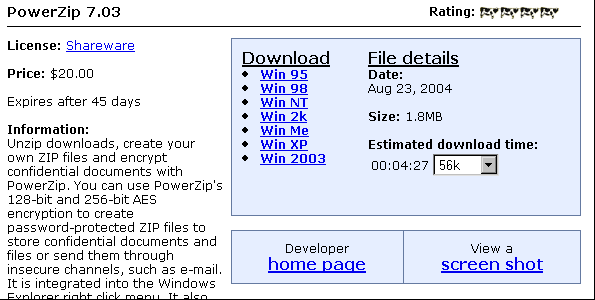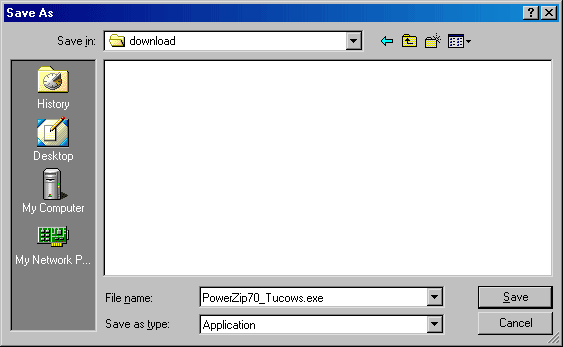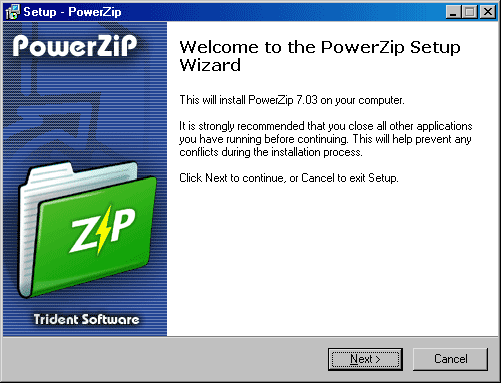How to Download Software From Exe Files
![]()
How to...
Downloading and installing software
- Introduction
- Zippo files
- Exe files
- Warning!
- Downloading a file from the web
- Installing software
- Dealing with *.exe files
- Self-installing *.exe files
- Dealing with *.exe files that do not self-install
- Dealing with all *.zip files
- Installing the program
Introduction
Most software available for downloading from the Web is usually contained in i or more files into which all the files necessary to install the software have been packed. The downloadable files will normally take the extension .zip or .exe.
To install the software on your PC, the files within these "containers" need to be unpacked. To ensure that the individual files are hands identifiable always download software into a new directory.
[back to top]
Zip files
Before installing, all of the files with the extension .nothing will need unpacking using an unpacking utility such as Power Aught. Power Zip is used in the following example for those who do non already accept an unpacking utility on their PCs.
[back to top]
Exe files
A file with the extension .exe is a program and its behaviour cannot exist predicted before running, i.e. double- clicking on the file. Information technology may start a self-installing Wizard, or start upwards an unpacking utility such as Power Null. In the worst instance, it could impairment your PC.
[back to acme]
Warning!
Installing new software is a loftier-risk activity. Malicious or desperately written installation programs can impairment your PC.
To avoid this happening:
- Just install programs that take been recommended by Information technology Services or technical back up staff in your Unit of measurement.
- NEVER double-click on an *.exe file that has been sent to you via unsolicited email.
There are many sites on the Web from which yous tin download software, however you must ensure that the site is reputable and that yous are fully aware of the blazon of license that applies to the software that you wish to install on your PC.
[dorsum to acme]
Downloading a file from the web
Always download files from the web into their own directory inside a temporary directory on your hard drive. This volition ensure that the files are easily identifiable.
As the first application you need to download may well be an unpacking utility, this example uses PowerZip. However, the following instructions apply to any file that tin can exist saved from your browser.
Having decided on which piece of software you require:
- Open Windows Explorer
- Create a folder within the temp folder on your hard drive, called, for example, download
- Discover the correct page for downloading the piece of software - in this instance a site called Tucows which is at http://www.tucows.com/:

N.B. Ensure that the software is for your operating system - e.g Win XP or Win 2000 - and that yous tin comply with the licensing conditions. NEVER download software from unknown sources.
- Print out and read any instructions provided
- Click on the appropriate link and salvage the file to the folder, c:\temp\download

- When the file has been successfully saved, close your browser.
[back to top]
Installing software
Having successfully saved the file, you lot are now ready to install the software onto your PC.
i. Dealing with *.exe files
Some downloadable files are self-extracting - i.e. do not crave a utility such as PowerZip to unpack them. These files usually have the extension .exe. In addition, an increasing number of this blazon of file automatically starts the installation process using a Wizard. Still, in most cases you lot will not know which type of file you lot have until you double-click on it.
For all *.exe files, the kickoff part of the process is the same:
- Close all open up applications
- Open up Windows Explorer
- Move to the Download sub-folder within the Temp binder
- Double-click on the file that yous take just downloaded from the Internet
[dorsum to tiptop]
two. Self-installing *.exe files
In the example nosotros are using the file is called PowerZip70_Tucows.exe. It is a well behaved self-installing executable and so a set-up wizard starts up. [If double-clicking does not automatically starting time the fix-upward process, delight go to the side by side section, three.Dealing with *.exe files that practise non cocky-install].
Continuing with our PowerZip example:
- The Setup Sorcerer automatically starts upwardly
- Click on Next
- Read any licensing rules carefully - e.grand. yous must register PowerZip within 30 days
- Follow the remaining steps in the Sorcerer - ensuring that the program is installed in its own folder under Program Files - the last step volition ofttimes be to restart your PC.

One time the installation procedure has been successfully completed:
- Test the program
- If everything works successfully delete the downloaded file from your folder; c:\temp\download
[back to top]
3. Dealing with *.exe files that do not self-install
Double-clicking on this type of file will not automatically commencement a set-up procedure. Instead, the files contained within the *.exe file will exist unpacked into the temporary binder that yous have created.
With Windows Explorer nonetheless open at the temporary folder that you have created:
- Printing the |[F5]| to refresh the screen - this will ensure that any files that have been unpacked are now visible in Windows Explorer
The remainder of the process is described in the department, five. Installing the program
[dorsum to pinnacle]
4. Dealing with all *.zip Files
All files with the extension .zip will need to exist unpacked using an unpacking utility such equally PowerZip. Later on unpacking they will then need to be installed as described in the section, 5. Installing the program.
Unpacking the files:

- Close all open applications including the Function Short-cut bar
- Open Windows Explorer
- Move to the Download folder within the Temp folder
- Right-click on the file that you have simply downloaded from the Net - this will open a brusk-cut menu
- Click on the selection: Extract to binder C:\TEMP\download\"filename"\
[dorsum to top]
5. Installing the Programme
As these types of compressed files do not cocky-install, you will now need to install the software. In nearly cases this volition involve double-clicking on one of the extracted files, unremarkably called setup.exe merely occasionally it might be called install.exe.
- If there is no such file, the extracted files must be copied to the appropriate place within your file structure, i.e. to their own sub-folder inside Program Files on the difficult drive.
Installing the Programme from an Extracted File:
- Ensure that all applications are airtight
- Open up the sub-binder containing the unpacked files
- Print off and read whatsoever Readme files that have been unpacked as these often requite further instructions regarding installation
- Double-click on the file, setup.exe - This should showtime up the installation Wizard
- Follow the steps in the Wizard - ensuring that the program is installed in its ain sub-folder on the hard drive - the last pace will oftentimes exist to restart your PC.
Alert!
Desperately behaved setup programs will install without a wizard, i.eastward. they will not prompt the user during the process. In these cases, you lot must check to see where it has installed itself.
Once the installation process has been successfully completed:
- Test the program
- If everything works successfully delete the downloaded file from your sub-directory; c:\temp\download
[back to top]
created on 2010-01-01 by Patricia OBrien
final updated on 2010-06-30 past Chris Limb
How to Download Software From Exe Files
DOWNLOAD HERE
Source: https://www.sussex.ac.uk/its/help/guide.php?id=53
Posted by: aliyahdaily7blogs.blogspot.com
0 comments